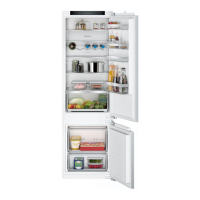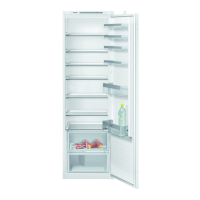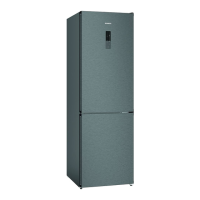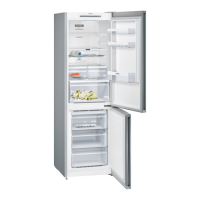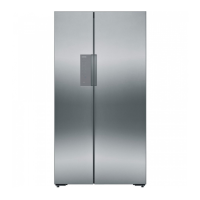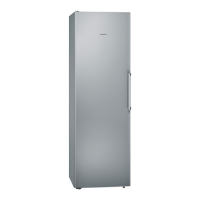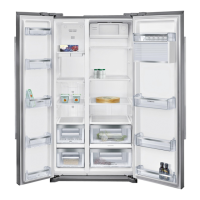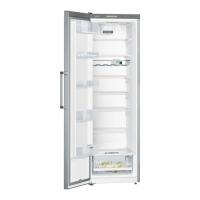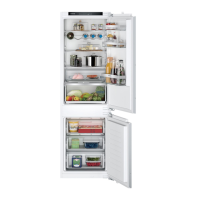
Do you have a question about the Siemens iQ300 KI85NH Series and is the answer not in the manual?
| Type | Fridge-freezer |
|---|---|
| Noise Level | 39 dB |
| Climate Class | SN-T |
| Freezing Capacity | 4 kg/24h |
| Installation Type | Built-in |
| Storage Time During Power Failure | 9 h |
| Door Hinge | Right reversible |
Essential information for safe operation, intended purpose, and user group restrictions.
Guidelines for safely moving and transporting the appliance to prevent injury.
Crucial safety instructions for appliance installation to prevent electric shock or explosion.
Safety precautions for appliance operation, covering electric shock, suffocation, and explosion risks.
Procedures for dealing with a damaged appliance or power cord, including repair warnings.
Instructions for environmentally friendly disposal of packaging materials.
Recommendations for optimizing appliance use to reduce power consumption.
Lists the components included in the appliance delivery and how to check for transport damage.
Guidelines for selecting a suitable installation location considering ventilation and room temperature.
Steps for physically installing the appliance according to enclosed instructions.
Steps to prepare the appliance before initial use, including removing protective materials and cleaning.
Instructions for safely connecting the appliance to the power supply.
An overview of the main parts and compartments of the refrigerator and freezer.
Explanation of the control panel functions, buttons, and indicator lights.
Instructions on how to remove and reposition shelves for flexible storage.
Guidance on storing bottles securely on the dedicated door shelf.
Information on the storage container's lower temperatures and suitability for perishable items.
How to use the container and its humidity control for optimal fruit and vegetable storage.
Instructions for removing and repositioning door racks for customized storage.
Overview of original accessories provided and their usage, like egg trays and ice cube trays.
Steps for electrically connecting and starting the appliance.
Advice for optimal appliance performance, including temperature acclimatization and door sealing.
Procedure for safely turning off the appliance using the control panel.
How to adjust the temperature in the refrigerator compartment for desired cooling.
Explanation of the Super function for intensive cooling and its activation.
Describes the door alarm that activates when the door is left open too long.
Explains the fan alarm indicating a potential issue with the freezer compartment fan.
Requirements and initial steps for connecting the appliance to the Home Connect app.
Instructions for establishing a Wi-Fi connection for the appliance's smart features.
How to switch off the appliance's connection to the WLAN home network.
Guidance on installing updates for the Home Connect software via the app.
Procedure to reset Home Connect settings if connection issues arise.
Details on data transmitted by the appliance when connected to Home Connect.
Best practices for storing food in the refrigerator to maintain freshness and prevent contamination.
Explanation of different temperature zones within the refrigerator compartment.
How to use the "OK" sticker to verify the refrigerator compartment's temperature.
Information on the appliance's ability to freeze food efficiently within a given time.
Tips for organizing and stacking frozen food to utilize the freezer's maximum capacity.
Guidelines for storing frozen food correctly to maintain quality and prevent freezer burn.
Recommendations for freezing fresh food, including preparation and packaging.
A table indicating the recommended storage duration for various foods at -18 °C.
Safe methods for defrosting frozen food to prevent bacterial growth and maintain quality.
Explanation of the automatic defrosting process in the refrigerator compartment.
Information that the NoFrost system in the freezer compartment eliminates the need for manual defrosting.
Steps to safely prepare the appliance before cleaning, including switching off and disconnecting power.
Instructions on how to clean the appliance safely, avoiding damage and electric shock.
Procedure for cleaning the condensation channel and drainage hole to prevent blockages.
Instructions on how to remove shelves and other fittings for thorough cleaning.
Advice on actions to take during a power failure and checking food quality afterwards.
How to perform an appliance self-test to identify and diagnose faults.
Steps to safely deactivate and prepare the appliance for storage or disposal.
Guidelines for environmentally friendly disposal of the old appliance, with safety warnings for children.
Information on finding and noting the appliance's E-Nr., FD, and Z-Nr. for service inquiries.
Details about software licenses and how to access license information for the appliance.
